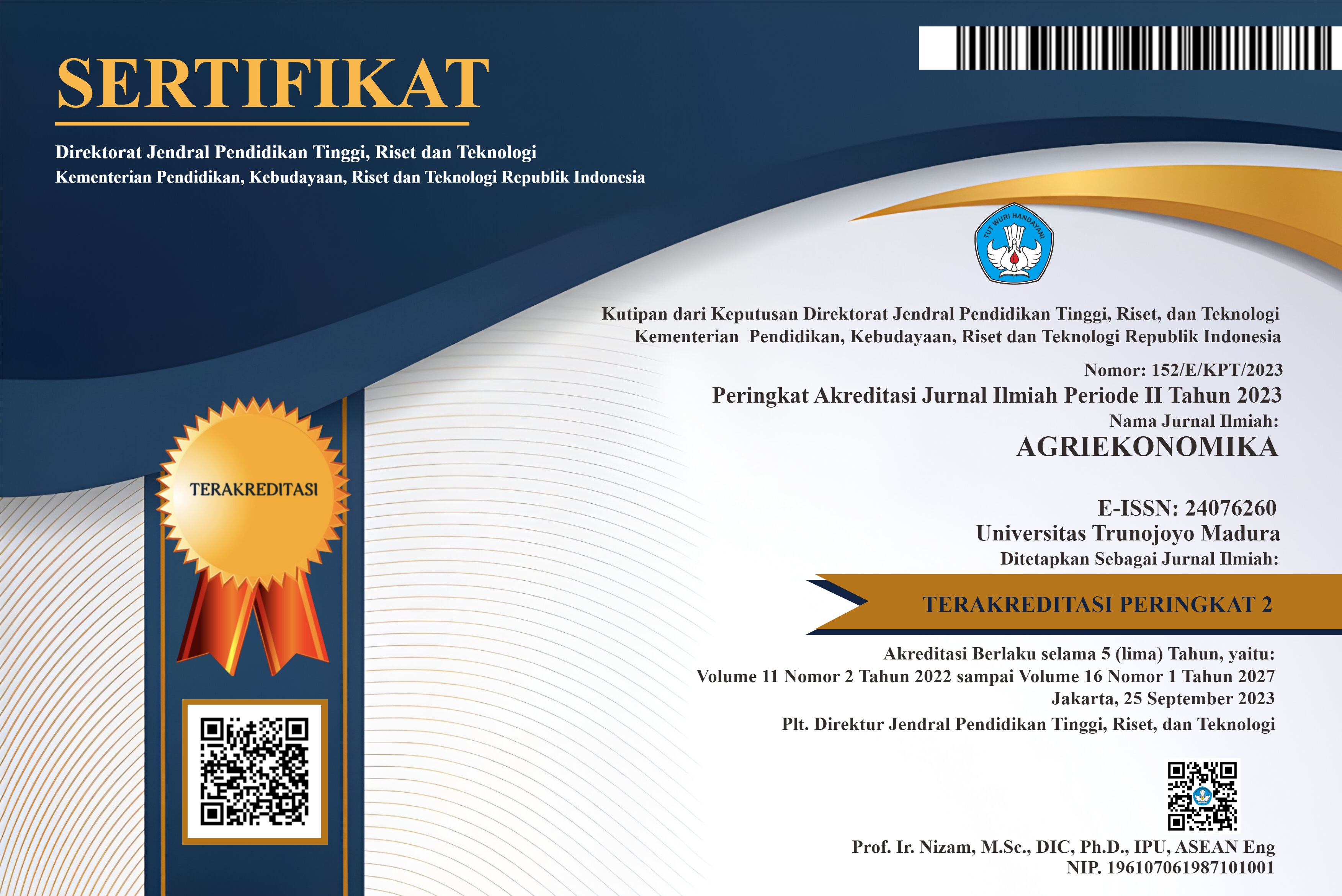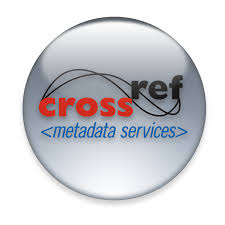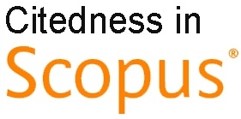Model Peramalan Inflasi Bahan Makanan Primer dengan Pendekatan Box-Jenkins: Studi kasus di Kota Palu
Abstract
Inflasi merupakan naiknya harga barang dan jasa secara umum dan berkelanjutan pada periode tertentu. Inflasi pada umumnya disebabkan oleh peningkatan permintaan agregat, kenaikan biaya produksi serta perkiraan nilai inflasi pada masa yang akan datang. Inflasi merupakan data deret waktu yang sulit diprediksi karena mengandung komponen tren, musiman, siklus, dan acak. Penelitian ini bertujuan untuk mencari model terbaik inflasi bahan makanan primer, menggunakan model ARIMA. Model terbaik yang diperoleh berdasarkan subkelompok bahan makanan adalah padi-padian, umbi-umbian, dan hasil-hasilnya (25,0,4): daging dan hasil-hasilnya (2,0,10): ikan segar (2,0,8): ikan diawetkan (2,0,8): telur, susu, dan hasil-hasilnya (12,0,20): sayur-sayuran (12,0,12): kacang-kacangan (14,0,13): buah-buahan (8,0,1): bumbu-bumbuan (1,0,1): lemak dan minyak (19,0,0) dan bahan makanan lainnya (25,0,3).
Keywords
Full Text:
PDFReferences
Aasim, Singh, S. N., & Mohapatra, A. (2019). Repeated Wavelet Transform Based ARIMA Model for Very Short-term Wind Speed Forecasting. Renewable Energy, 136, 758–768. https://doi.org/10.1016/j.renene.2019.01.031
Adrián Risso, W., & Sánchez Carrera, E. J. (2009). Inflation and Mexican Economic Growth: Long‐run Relation and threshold effects. Journal of Financial Economic Policy, 1(3), 246–263. https://doi.org/10.1108/17576380911041728
Ahmed, D. A., & Abdelsalam, M. A. M. (2017). Inflation Instability Impact on Interest Rate in Egypt: Augmented Fisher Hypothesis Test. Applied Economics and Finance, 5(1), 1. https://doi.org/10.11114/aef.v5i1.2709
Aiken, M. (1999). Using a neural network to forecast inflation. Industrial Management & Data Systems, 99(7), 296–301. https://doi.org/10.1108/02635579910291984
Arlt, J., & Arltova, M. (2015). Forecasting of the Annual Inflation Rate in the Unstable Economic Conditions. 2015 Second International Conference on Mathematics and Computers in Sciences and in Industry (MCSI), 231–234. https://doi.org/10.1109/MCSI.2015.34
Badan Pusat Statistik. 2016.Indeks Harga Konsumen (IHK). Jakarta : BPS.
Cheng, M., & Tan, H. (2002). Inflation in Malaysia. International Journal of Social Economics, 29(5), 411–425. https://doi.org/10.1108/03068290210423532
Fukuda, S., & Soma, N. (2019). Inflation target and anchor of inflation forecasts in Japan. Journal of the Japanese and International Economies, 52, 154–170. https://doi.org/10.1016/j.jjie.2019.01.002
Hedenstierna, G. (2018). Unstable Inflation Is Harmful and More Common Supine Than Prone. American Journal of Respiratory and Critical Care Medicine, 198(2), 146–147. https://doi.org/10.1164/rccm.201802-0313ED
Hong, T., Kim, C.-J., Jeong, J., Kim, J., Koo, C., Jeong, K., & Lee, M. (2016). Framework for Approaching the Minimum CV(RMSE) using Energy Simulation and Optimization Tool. Energy Procedia, 88, 265–270. https://doi.org/10.1016/j.egypro.2016.06.157
Huang, H.-C., Yeh, C.-C., & Wang, X. (2019). Inflation Targeting and Output-Inflation Tradeoffs. Journal of International Money and Finance, 96, 102–120. https://doi.org/10.1016/j.jimonfin.2019.04.009
Khashei, M., Bijari, M., & Raissi Ardali, G. A. (2012). Hybridization of Autoregressive Integrated Moving Average (ARIMA) with Probabilistic Neural Networks (PNNs). Computers & Industrial Engineering, 63(1), 37–45. https://doi.org/10.1016/j.cie.2012.01.017
Lee, S., & Kim, Y. M. (2018). Inflation Expectation, Monetary Policy Credibility, and Exchange Rates. Finance Research Letters. https://doi.org/10.1016/j.frl.2018.12.006
Lidiema, C. (2017). Modelling and Forecasting Inflation Rate in Kenya Using SARIMA and Holt-Winters Triple Exponential Smoothing. American Journal of Theoretical and Applied Statistics, 6(3), 161. https://doi.org/10.11648/j.ajtas.20170603.15
Matyjaszek, M., Riesgo Fernández, P., Krzemień, A., Wodarski, K., & Fidalgo Valverde, G. (2019). Forecasting coking coal prices by means of ARIMA models and neural networks, considering the transgenic time series theory. Resources Policy, 61, 283–292. https://doi.org/10.1016/j.resourpol.2019.02.017
Mentaschi, L., Besio, G., Cassola, F., & Mazzino, A. (2013). Problems in RMSE-based wave model validations. Ocean Modelling, 72, 53–58. https://doi.org/10.1016/j.ocemod.2013.08.003
Mills, T. C. (2019). ARIMA Models for Nonstationary Time Series. In Applied Time Series Analysis (pp. 57–69). https://doi.org/10.1016/B978-0-12-813117-6.00004-1
Pincheira-Brown, P., Selaive, J., & Nolazco, J. L. (2019). Forecasting inflation in Latin America with core measures. International Journal of Forecasting, 35(3), 1060–1071. https://doi.org/10.1016/j.ijforecast.2019.04.011
Roncaglia de Carvalho, A., Ribeiro, R. S. M., & Marques, A. M. (2018). Economic development and inflation: a theoretical and empirical analysis. International Review of Applied Economics, 32(4), 546–565. https://doi.org/10.1080/02692171.2017.1351531
Sotola, V. A., Craig, C. A., Pfaff, P. J., Maikoetter, J. D., Martin, N. H., & Bonner, T. H. (2019). Effect of preservation on fish morphology over time: Implications for morphological studies. PLOS ONE, 14(3), e0213915. https://doi.org/10.1371/journal.pone.0213915
Torbat, S., Khashei, M., & Bijari, M. (2018). A hybrid probabilistic fuzzy ARIMA Model for Consumption Forecasting in Commodity Markets. Economic Analysis and Policy, 58, 22–31. https://doi.org/10.1016/j.eap.2017.12.003
Yuan, C., Liu, S., & Fang, Z. (2016). Comparison of China’s Primary Energy Consumption Forecasting by using ARIMA (The Autoregressive Integrated Moving Average) Model and GM(1,1) Model. Energy, 100, 384–390. https://doi.org/10.1016/j.energy.2016.02.001
DOI: https://doi.org/10.21107/agriekonomika.v9i1.6440
Refbacks
- There are currently no refbacks.







